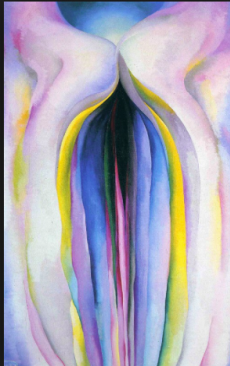
Email: lienaaltai@icloud.com
Total Article : 47
About Me:Sixth form student with an interest in a wide variety of topics such as languages, history, philosophy, politics and literature

Georgia O’keefe began her career in art at a very early age – being encouraged by her mother to study art and paint from the time she started school. By the age of 9, O’keefe had already decided her career as an artist. Her background was that of a family in which female education was encouraged, meaning she would study at the school of the art institute. In the late 19th century, female empowerment remained low, and the patriarchy remained in full power and swing. The powerful femininity of O’keefe as a person and artist is deeply rooted in this background of 1880’s Wiscosin. Moving to new York in 1907 also influenced her artwork, and led to her meeting photographer Alfred Stieglitz – the two would go on to make art and photos together in what would become a legacy of empowering portraits and landscapes. During the 1920s, O’keefe would meet many artists through Stieglitz such as Marsden Hartley, John Marin and Paul strand. As their modernist style influenced O’keefes work further, her paintings evolved and began to pick up lots of attention. Her time in New York was followed by time in new Mexico in which O’keefe slowly became one of the most influential artists of her era. Her vibrant, different palette, daring style and variation from abstract to figurative made her stand out, especially in the early 20th century. Stieglitz’ portraits also compromised of intense authoritative headshots, and very unsubtle nudes which would embody the empowerment of her female form.
Georgia o’keefe’s pioneering role as a feminist artist still lives on to this day. She produced over 2000 works over the course of her career, and her impact on the art world still resonates. Whilst her art remained grounded in representational art, she did not adhere to a specific style. Influenced by many artists, O’keefe achieved great impact through focus on detail in cropping of flowers and objects, use of colour and line to invoke forms and shapes not common of the era. Her famous flower series is still talked about to this day – with the infamous debate of the sexual nature of her works. Feminist critiques state that her close ups of flowers represent erotic and sexual nature, a daring move in time period she painted in. whilst O’keefe herself denied this, many viewers still support this critique, shapes and colours in her paintings seeming very suggestive.
A prime example of this is in the painting “grey lines with black, blue, and yellow”. The cropping of the frame imitates styles seen in much of the photography that O’keefe was surrounded by, and immediately draws us into an intimate and close encounter with what is being portrayed. The arching lines work together with the soft hues to portray a very sensual scene – as critics have mentioned, potentially abstractions on the female anatomy. The lines may also resemble petals of a flower, as O’keefe herself said that her painting was based on.
http://www.georgiaokeeffe.net/grey-line-with-black-blue-and-yellow.jsp

0 Comment:
Be the first one to comment on this article.